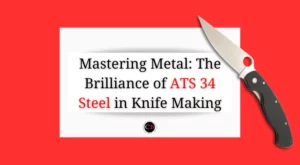15n20 steel has remarkable properties that make it a popular choice for making Damascus knives, among other things.
But, is 15n20 steel good for knives?
I did some research and compiled my findings in the article below. So if you want to know more about 15n20 steel, such as details about its composition, its properties in terms of hardness, wear resistance, corrosion resistance or how it is suitable as a knife steel, stay tuned and read on.
Table of Contents
What exactly is 15n20 steel?
15n20 steel is a development of the Austrian manufacturer Böhler-Uddeholm with high carbon and high nickel content, which is popular mainly as band saw steel because of its great toughness and versatility. It is similar to AISI L6 tool steel, except for the lack of chromium.
15n20 is used either as a stand-alone material for saw blades or mixed with other steels in pattern-welded Damascus steel (Damascus steel for short). For example, blends of 15n20 and AISI 1095 steel or 15n20 and AISI 1084 steel are quite popular.
The nickel content in 15n20 steel provides the bright parts in the damascus steel and thus a good contrast. 15n20 is easy to sharpen, achieves good sharpness, but does not retain it for very long – its above-average toughness is its main characteristic.
Nevertheless, it is used by Western knife manufacturers – but then with higher hardness – for kitchen knives. It is also used to make swords. Since it is relatively easy to machine, 15N20 is a great steel for beginners and professionals who want to use it for knife making.
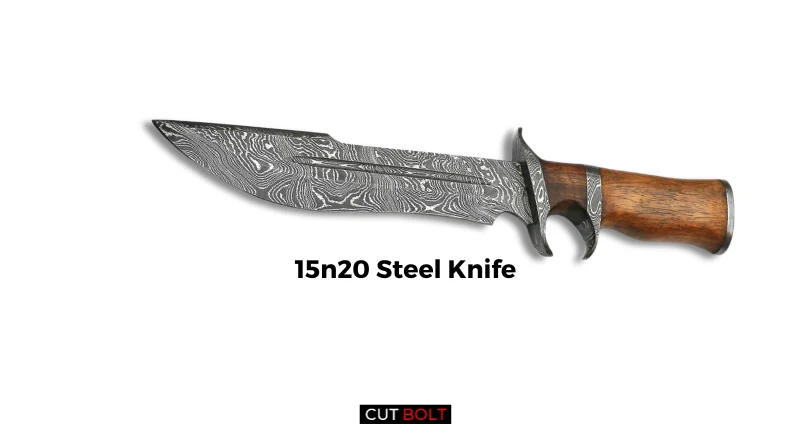
Is 15n20 a high carbon steel?
Yes, 15N20 is considered a high carbon steel. High carbon steels are those that contain a higher percentage of carbon compared to other steels. They typically have a carbon content ranging from 0.60% to 1.00%. These steels are known for their hardness, strength, and durability, making them suitable for applications where wear resistance and toughness are crucial.
15N20 specifically is a high carbon nickel steel known for its excellent edge retention and toughness, making it a popular choice for knife making. It is often used in combination with other steels, like 1084, to create Damascus or pattern-welded steel, which combines the desirable properties of both metals. The nickel content in 15N20 also adds an element of corrosion resistance, further enhancing its suitability for blades.
What is 15n20 steel used for
The main use of 15n20 is probably as steel for band saw blades. 15n20 is a stainless steel which is mainly used in the making of fillet knives which are frequently found in the kitchen sector in order to give them more shine.
It is available in different lengths, widths, heights and offers a good adaptation to all your projects and is not only very easy to work with, but also very easy when heat treating them.
It is also used in woodworking tools and for the production of Damascus steel, for which it is fire-welded with compatible steels such as AISI 1095 or AISI 1084.
Chemical composition of 15n20 steel
| Element | Portion | Effect |
| Carbon | 0.75% | Increasing hardness and tensile strength. In larger quantities, increase in brittleness and reduction in forgeability and weldability. |
| Manganese | 0.40% | Improves hardness and tensile strength. |
| Nickel | 2.0% | Nickel increases tensile strength and yield strength. From 8% increase in corrosion resistance. |
| Phosphorus | 0.02% | Increases tensile strength, hardness and corrosion resistance but also brittleness. |
| Sulfur | 0.01% | Increases machinability but also brittleness. |
| Silicon | 0.30% | Improves strength. |
The chemical composition of 15n20 is special because it does not contain any chromium. This makes it clear that the steel will not be corrosion resistant. However, other elements, and here especially the nickel, contribute to the fact that the steel nevertheless has some very interesting properties.
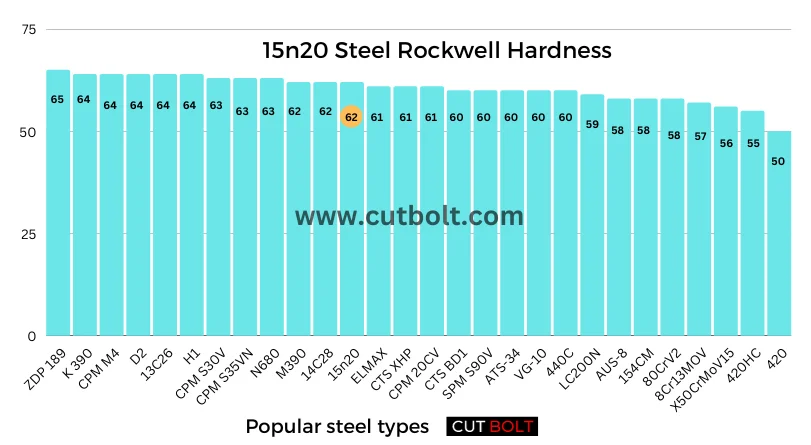
What is the hardness (HRC) of 15n20 steel?
According to Alpha knive supply, 15n20 has sufficient toughness to be used at a hardness of HRC 61-62. It is resistant to chipping, and the main application for this steel is band saw blades in sawmills.
Depending on the heat treatment used, the hardness of the steel may vary more or less. The high proportions of carbon and nickel in its composition are responsible for the steel’s high degree of hardness.
The high nickel content gives the steel its high degree of hardness, which sets 15N20 apart from other/comparable steels. 15n20 is abrasion and wear resistant, so that the blade is not scratched or deformed during heavy use.
Is 15n20 rustproof or a stainless steel?
15n20 is not a stainless steel. To be considered stainless, it would require – depending on the definition – a chromium content of at least 10.5 – 13% chromium, which must be dissolved in the austenite or ferrite (see here). However, 15n20 does not contain any chromium at all.
What is 15n20 then? According to Tharwa Valley Forge (Australian Bladesmithing School), 15n20 is a tool steel and by definition also a (non-stainless) steel, since its sulfur and phosphorus content (so-called iron companion) does not exceed 0.025%.
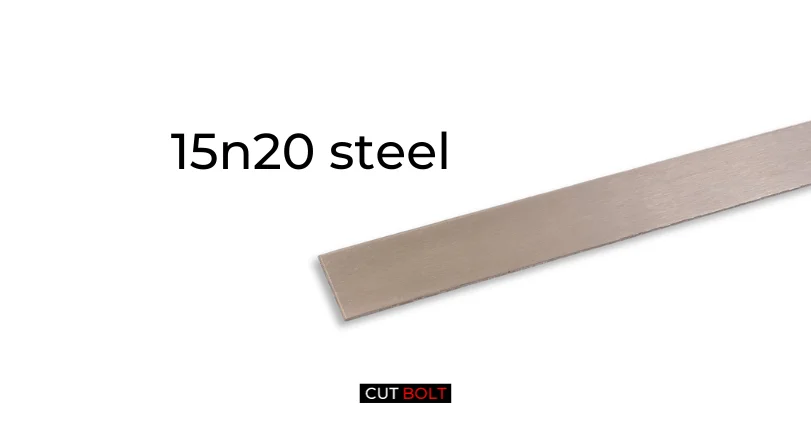
Is 15n20 a carbon steel?
15n20 steel contains 0.75 – 0.8% carbon. This makes it a carbon steel according to the definition of carbon steel (Carbon Steel, Wikipedia) of the American Iron and Steel Institute (AISI), according to which a steel is considered a carbon steel if it contains at least 0.05% carbon.
Properties of 15n20 steel
According to its chemical composition and hardness of 15n20 provides:
1. Edge retention
15n20 is a hard steel with good enough edge retention for knives. That being said, does not show the best performance in terms of edge retention. When 15n20 is compared to 1084 in terms of edge retention, it is clearly inferior to it in a direct comparison. Still, because of the nickel in the alloy, a well-crafted blade made from 15N20 steel will give you a cutting edge retention that is quite usable in everyday use.
2. Corrosion resistance
Due to the complete absence of chromium in the chemical composition of 15n20 steel, it is to be expected that the steel will have virtually no corrosion resistance. Surprisingly, however, corrosion resistance is somewhat improved by the presence of nickel. Nevertheless, the steel needs care – by cleaning it after use, keeping it clean and dry, and preserving it with (knife) oil.
3. Wear resistance
Unsurprisingly, 15n20 has a high wear resistance, as it has a high hardness. The presence of manganese and silicon in its composition makes the steel even more durable in terms of its resistance to wear and abrasion.
4. Sharpenability
15N20 is easy to sharpen by simple means and is therefore ideal for sharpening “in the field”. Despite the high hardness of 15n20 steel, it is not difficult to sharpen. Compared to other high carbon steels, it is much easier to give a 15n20 steel blade an appropriate sharpness – this property is also due to the nickel in the alloy.
5. Toughness
Since the hardness of steel is indirectly proportional to its toughness, one would expect 15N20 to have the lowest toughness due to its high hardness.
However, the high nickel content in the composition of the steel ensures that it is extremely resistant to breakage and chipping.
X50CrMoV15 Steel
Related: What is X50CrMoV15 steel
How to heat treat 15n20 steel?
Heat treating 15N20 steel involves a process known as quenching and tempering. Here’s a basic guide on how to heat treat 15N20 steel:
1. Preparation:
- Ensure your work area is well-ventilated and equipped with necessary safety gear, including gloves, eye protection, and heat-resistant clothing.
- You’ll need a heat source (like a forge or a kiln), a quenching medium (usually oil or water), and an oven for tempering.
2. Normalization:
- Heat the 15N20 steel slowly and uniformly to around 1600°F (871°C).
- Hold it at this temperature for a short period to relieve any internal stresses.
3. Hardening (Quenching):
- Heat the steel to its critical temperature, which is typically around 1500°F (816°C).
- This is the point where the steel becomes non-magnetic. You can check this with a magnet. When the steel no longer sticks to the magnet, it’s ready for quenching.
- Quickly transfer the heated steel to your chosen quenching medium (oil or water). Be cautious, as this process can be quite violent, especially with water.
4. Tempering:
- After quenching, the steel will be extremely hard but also very brittle. To increase toughness and reduce brittleness, tempering is necessary.
- Preheat your oven to the desired tempering temperature. For 15N20 steel, a typical tempering temperature might be between 350°F to 450°F (177°C to 232°C).
- Place the quenched steel in the oven and hold it at the chosen tempering temperature for a specific amount of time. The duration of tempering depends on the desired balance of hardness and toughness.
5. Cooling:
Allow the steel to cool slowly in the oven after the tempering process is complete.
6. Final Steps:
- Once the steel has cooled, it should have the desired combination of hardness and toughness for its intended use.
- If necessary, further grinding, polishing, and sharpening can be done to achieve the final desired shape and edge.
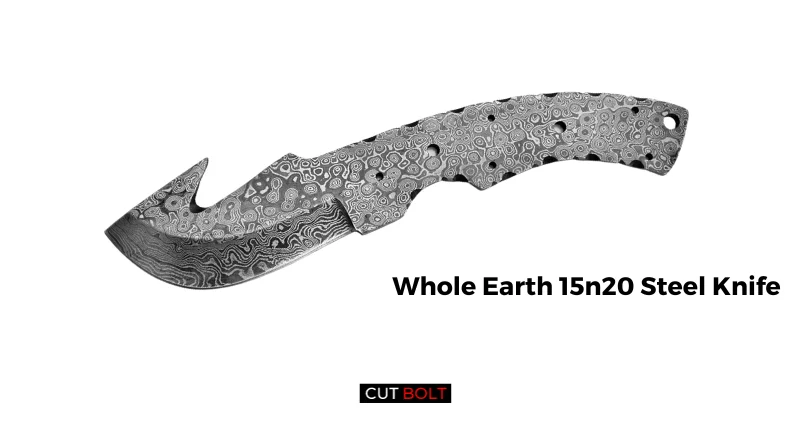
Is 15n20 a good knife steel?
Yes, 15n20 is good steel for knives. 15n20 enjoys great popularity, especially for cooking, filleting and Damascus knives as it is versatile and offers an ideal balance between toughness and hardness.
Due to its high toughness, sufficiently good edge retention, and ease of sharpening, it is a great steel for knives and swords, despite its less than optimal corrosion resistance, but this can be countered with proper care.
Quenching and tempering it is comparatively easy, which makes it popular with knife manufacturers. The only drawback is its low corrosion resistance, but this can be effectively counteracted by appropriate care, such as cleaning and oiling after use.
The advantages of 15n20 steel
15n20 steel offers several among which we have:
- It is very robust and easy to sharpen
- It can be used both for the production of knives, but also for that of swords
15n20 steel is one of several stainless steels used by many knife makers and is primarily popular for the shine it gives to Damascus knives, but also for maintaining sharpness. Easy to quench and heat, it represents good steel and not many problems.
15n20 steel – equivalents
The steel that is probably closest to 15n20 is AISI L6. Both have a high nickel content (more than 1.75%), both offer good edge retention, high wear resistance, hardness and low corrosion resistance. They are also in the same price range.
Comparison of 15N20 with other knife steels
1. 15n20 vs. 1095
15n20 outperforms 1095 high-carbon steel in many steel properties, such as edge retention, toughness, and ease of sharpening due to its high nickel content in its composition. In addition, 15n20 is easier and more flexible to work with compared to 1095 steel. In terms of corrosion resistance, both knife steels offer less good performance.
2. 15n20 vs. 1080
1080 steel contains a higher percentage of carbon and manganese compared to 15n20, which increases its hardness. 15n20 is superior to 1080 in terms of toughness.
Conclusion: Is 15N20 steel good for knives
All in all, 15n20 is a great low-end steel. Not the best, it still has many qualities that you would like to have in a knife. These include good enough edge retention, high toughness, and ease of sharpening.
It is also interesting for the production of Damascus steel due to the good weldability with other (compatible) steels and the comparatively easy tempering.
The only downer is its low corrosion resistance due to the total absence of chromium, but this can be countered by appropriate care such as cleaning and oiling after use.


